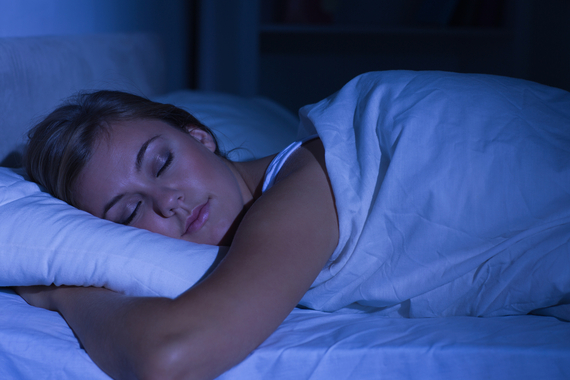by Dr. Angel Morgan
It's one of the big questions, right up there with the other big mystery question, "Why do we exist?" and it has puzzled and inspired scientists and researchers for decades: Why do we dream?
There is not one answer. But everyone does it. It's as natural as breathing, and just as much of an involuntary activity -- even people who don't remember dreaming actually do, for at least one to two hours every night.
Early observations of sleeping infants led to sleep studies with adults, and the subsequent literature about rapid eye movement, or REM, became the foundation for laboratory-based dream studies (1). REM is the sleep period considered most favorable for ordinary dreaming.
Infants experience REM during about 50 percent of sleep, but by adulthood that has declined to an average of 22 percent (2).
For most adults, REM sleep occurs every 90 minutes. The first cycle starts out as short as three minutes, but the duration increases with each cycle, so by early morning, the last cycle can last up to 55 minutes.
During REM sleep, muscles are temporarily paralyzed -- protecting us from physically acting out these dreams with our bodies. Interestingly, it's not just our eyes that move rapidly, but our fingers and toes, too (3). While it was long believed that dreams happened only during REM sleep, it's now understood that there are different kinds of dreams that can happen during other sleep cycles, as well (4).
We sleep for about one-third of our lives, and we have REM-sleep dreams for about one quarter of that time. With the realization that dreams also happen during "Non-REM" sleep, researchers have discovered that the time a person actually spends dreaming could be even longer.
It's easy to see during sleep studies that people do dream -- but it's much more difficult for researchers to agree on why. Even during conferences held by experts in the field of dream studies, there's not an overall consensus for why we dream. But there are certainly a lot of theories.
Dreams happen for physical, mental, emotional and even spiritual reasons, and there is widespread agreement that dreams can present opportunities for creativity, growth, health and wholeness. Dreams help us know ourselves better.
The time we spend dreaming can also help us solve problems by giving our minds free rein to examine all possible scenarios. In dreaming, our waking-life barriers come down, and new ideas can spring forth freely.
One of the best features of ordinary dreams is that they can help us get in touch with our feelings, because in our waking lives, our rational, thinking minds can often get in the way.
For instance, legendary golfer Jack Nicklaus was having trouble with a golf swing -- but in a dream he was "hitting them pretty good." He told a San Francisco Chronicle reporter that he noticed that his hands were positioned differently in the dream, and the next day he remembered the grip, shaving three points off his game (5).
That's just one example of how dreams can have an impact on daily life -- and there are many, from Paul McCartney hearing the tune of Yesterday in a dream, to Stephen King dreaming up the idea for his best-selling book, Misery (6, 7).
Dreams also allow us to rehearse or practice for future events, learn about our bodies' physical needs, improve our diets, and heal emotional wounds from troubled relationships (8).
It's a frequently asked question by DreamsCloud users, and most people would probably like to understand what happens during that lengthy period of time each night when different parts of our brains become active (9). Dream researchers may never reach consensus about why dreams happen, but they continue to provide an increasing amount of evidence that dreams play a much more important role in our lives and health than many people have previously imagined.
DreamsCloud is a place to log and share your dreams, keep an online dream journal, learn more about dream meanings and receive professional dream reflections. They offer a free app for iOS, Android, Windows and Blackberry devices, in addition to a Facebook app.
Blog author Angel Morgan, Ph.D., completed the Dream Studies and Creativity Studies programs at Saybrook University. Her research can be found on academia.edu. Dr. Morgan also oversees the experienced dream reflectors at DreamsCloud, providing feedback and insight for dreams submitted by users worldwide.
References:
(1) Aserinsky, E., & Kleitman, N. (1953). Regularly occurring periods of eye motility, and
concomitant phenomena during sleep. Science 118, 273-74.
(2) Van de Castle, R. L. (1994) Our Dreaming Mind: A sweeping exploration of the role
that dreams have played in politics, art, religion, and psychology, from ancient civilizations to the present day. New York: Ballantine Books. 233.
(3) Krippner, S., & Combs, A. (2000). Self-organization in the dreaming brain. Journal of
Mind and Behavior, 21, 400.
(4) Krippner, S., Bogzaran, F., & De Carvalho, A. P. (2002). Extraordinary Dreams and How
to Work With Them. New York: SUNY Press. 6, 18.
(5) Barrett, D. (2001). The Committee of Sleep: How artists, scientists, and athletes use dreams for creative problem solving--and how you can too (1st ed.). New York,
NY: Crown Publishers.
(6) Moss, R. (2009). The Secret History of Dreaming. Novato, CA: New World Library. 131.
(7) King, S. (1987) Misery. New York: Viking Press. Inspiration Retrieved from
http://www.stephenking.com/library/novel/misery_inspiration.html
(8) Morgan, A. K. (2011). Investigating experienced links between dreams and
creativity in the work of professional creative artists. (Doctoral dissertation).
(9) Hobson, J. A. (2001). The Dream Drugstore: Chemically altered states of
consciousness. Cambridge, MA: MIT Press.

